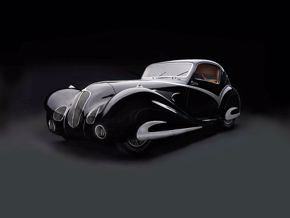Dangerous Curves: A “Sculpted in Steel” Chat with Ken Gross March 30, 2016

Bodywork designed by Figoni & Falaschi, Delahaye, 135M Competition Coupe, 1936, the Patterson Collection. Image © 2008 Peter Harholdt
Installation view of Sculpted in Steel: Art Deco Automobiles and Motorcycles, 1929–1940.
Ken Gross, a car historian and former director of the Petersen Automotive Museum in Los Angeles, lent his expertise to the exhibition Sculpted in Steel: Art Deco Automobiles and Motorcycles, 1929–1940 as guest co-curator. He has also shared insights with publications from AutoWeek and Hemispheres to Playboy—which naturally got us thinking, what’s the deal with cars, sensuality, and glamour? I asked Ken some PG-rated questions to figure it out.
Why do cars lend themselves so readily to sensuality? (Is it really just the curves?)
Many of these cars on display were designed to be sensual, aesthetically arousing, impactful, and, if you will, a bit outrageous.
The French firm Figoni and Falaschi led carrossiers (coachbuilders) in exploiting the teardrop form from both a functionally streamlined and attractively curvaceous point of view. Artists like Geo Ham (Georges Hamel) sketched fantastical shapes on wheels, and Figoni and Falaschi’s craftsmen were able to duplicate the designs in aluminum, to the delight of all who saw them.
The formula for sensuality included a long hood, a small cabin (just two seats), a rakish tail, and lots of curves. Just look at a Delahaye 135MS for proof. Some of these cars have been compared to the lovely shape of a woman’s body, or even a Paris gown on wheels.
Formal elements of curvaceousness and power aside, cars also became associated with luxury and Hollywood glamour. How did that come to be? Do vehicles still hold that same connotation today?
In the 1920s and 1930s, stars’ agents, and public relations people for film studios, sought to portray their clients in every luxurious setting. Their clients were “movie stars,” and as such, even everyday existence was portrayed as larger than life and shown in movie newsreels and magazines.
Clark Gable and Gary Cooper, along with James Cagney, Tyrone Power, Bill “Bojangles “ Robinson, and Joe E. Brown, all drove Duesenbergs—the most luxurious American car. Gable later had the first Jaguar XK120 in Hollywood and one of the first Mercedes-Benz 300SL Gullwings. Marlene Dietrich drove a custom-built Rolls-Royce.
Today, you have James Bond and his Aston Martin, and many films like The Fast and the Furious, where the car is the star.
What does it say about car design that these eye-catchingly opulent vehicles were made during the Great Depression?
When the Depression began in 1929, no one knew or predicted that it would last as long as it did. Duesenberg launched the Model J—the most powerful and expensive car in America—in 1929, just before the stock market crashed.
Luxury auto companies and coachbuilders still solicited commissions from wealthy clients, and some of the most fabulous classic cars of all time were built in the mid-1930s.
Even when war clouds appeared on the horizon, there were still those who commissioned custom-built cars, perhaps so they’d have them in the event of a conflict—which no one thought would last forever anyway. Even though the world economic situation became grim, all wealth didn’t dry up, and creativity didn’t cease.
See “Sculpted in Steel” in the Beck Building through May 30.





